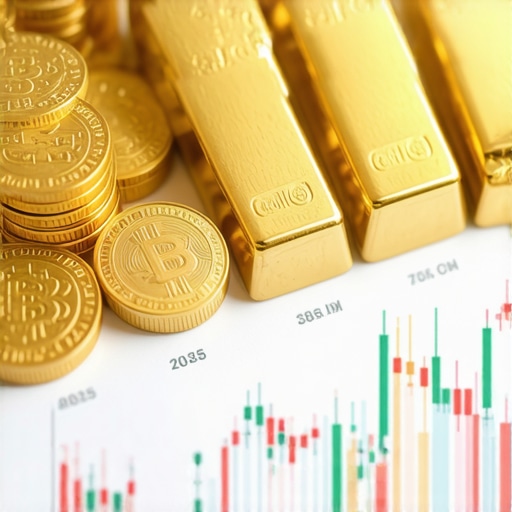Introduction to Gold Investments: A Beginner’s Guide
Investing in gold has become a popular choice among investors looking to diversify their portfolios and hedge against economic uncertainty. As a tangible asset, gold not only retains intrinsic value but also offers a sense of security during market volatility. In this comprehensive guide, we will explore the various types of gold investments available to potential investors and help you determine which options align with your financial goals.
Exploring the Different Types of Gold Investments
When considering types of gold investments, it’s essential to understand not only the options available but also the pros and cons associated with each. Here are the most common forms of gold investments:
1. Physical Gold: Bars and Coins
Physical gold is perhaps the most traditional form of investment. Investors can buy gold bars or gold coins and store them securely. This type of investment allows you to have direct ownership of the asset, giving you peace of mind. However, owning physical gold can come with additional costs such as storage and insurance.
2. Gold ETFs: A Convenient Alternative
Gold exchange-traded funds (ETFs) offer a way to invest in gold without the need for physical storage. These funds track the price of gold and can be bought or sold just like stocks on the stock exchange. Investing in gold ETFs provides liquidity and ease of trading, making them an attractive option for many investors.
3. Gold Mutual Funds
Gold mutual funds pool money from multiple investors to invest in a diversified portfolio of gold-related securities. This can include shares of gold mining companies, making it a more indirect way to invest in gold. While this option can reduce risk through diversification, it may also result in higher management fees.
4. Gold Futures and Options
For more experienced investors, gold futures and options offer opportunities to hedge against price fluctuations or speculate on future price movements. However, these instruments come with higher risks and require a deeper understanding of the market.
5. Gold Mining Stocks
Investing in gold mining stocks allows investors to gain exposure to gold prices indirectly. As gold prices rise, mining companies tend to see increased profits, which can lead to higher stock prices. However, investing in mining stocks can be subject to additional risks, including operational issues and management decisions.
Conclusion
Understanding the different types of gold investments is crucial for making informed decisions in your investment journey. Whether you opt for physical gold, ETFs, or mining stocks, each investment type offers unique benefits and risks. As you navigate the world of gold investing, consider your financial goals and risk tolerance. For more insights and strategies on gold investments, check out our resources on gold investment strategies and guides for beginners to ensure you’re making the best choices for your portfolio.
Understanding Gold Investment Strategies for 2025
As you delve deeper into the world of gold investments, it’s essential to formulate a robust investment strategy that aligns with the current market trends and your personal financial objectives. By analyzing the latest gold demand insights, you can make informed decisions that enhance your investment outcomes.
1. Diversification: A Key to Risk Management
One of the fundamental principles of investing is diversification. By spreading your investments across various types of gold assets—such as physical gold, ETFs, and mining stocks—you can mitigate risks associated with market fluctuations. This approach not only stabilizes your portfolio but also increases your chances for potential gains in different market conditions.
2. Timing Your Investments: Understanding Market Trends
Timing can significantly affect your gold investment outcomes. Keeping abreast of market trends and forecasts allows you to identify optimal entry and exit points. For example, during economic uncertainties, gold often sees increased demand, making it a strategic time to invest.
3. Regular Market Analysis: Staying Informed
Regularly analyzing market conditions is crucial for any investor. Understanding how external factors, such as geopolitical events and economic indicators, influence gold prices equips you to adapt your strategy effectively. For comprehensive insights, consider reviewing articles on analyzing gold demand trends to stay ahead.
Exploring Advanced Gold Trading Techniques
For those looking to enhance their approach, diving into advanced gold trading techniques can unlock new opportunities for profit maximization. Here are some strategies to consider:
1. Leveraging Gold Futures and Options
Utilizing gold futures and options can provide more sophisticated investment opportunities. These financial instruments allow you to speculate on future price movements, offering potential high returns. However, they do come with increased risks and require a solid understanding of market dynamics.
2. Keeping an Eye on Central Bank Activities
The actions of central banks can have a profound impact on gold prices. Monitoring central bank purchases can provide insights into future price movements. When central banks increase their gold reserves, it often signals a bullish trend for gold prices.
3. Utilizing Technical Analysis
Employing technical analysis can enhance your trading strategy by identifying patterns and trends in gold price movements. Tools such as charts and indicators help investors make data-driven decisions. For beginners, understanding the basics of technical analysis is vital and can be explored further in guides like understanding gold trading techniques.
Conclusion
By adopting a well-rounded approach to gold investing, you position yourself to maximize returns and minimize risks. Whether you are a novice or an experienced investor, staying informed about market trends and employing strategic techniques is crucial for success in the gold market. As you continue your journey in gold investment, utilize resources that provide insights into investment strategies and tips to refine your approach and achieve your financial goals.
Maximizing Returns: Critical Gold Investment Techniques
As the gold market continues to evolve, applying effective investment techniques becomes paramount. These strategies not only enhance profitability but also aid in navigating market volatility.
1. Understanding Gold ETFs and Their Advantages
Investing in gold ETFs can be a strategic choice for many investors. These funds offer exposure to gold prices without the need to hold physical assets, making them a convenient option. Additionally, they typically have lower fees compared to traditional mutual funds, providing a cost-effective way to invest in gold.
2. Emphasizing Physical Gold Investments
While ETFs and stocks are popular, many investors still value physical gold investments. Gold coins and bars not only serve as a hedge against inflation but also offer tangible assets that can provide peace of mind. Understanding the key considerations when investing in physical gold, such as authenticity and storage options, is crucial.
3. Exploring Gold Mining Stocks
Investing in gold mining stocks can also yield substantial returns. These stocks tend to rise in value when gold prices increase, allowing investors to capitalize on market movements. However, due diligence is necessary, as mining operations can be influenced by various factors, including operational efficiency and geopolitical risks.
Staying Ahead: Monitoring Gold Market Indicators
Successful gold investors keep a close eye on market indicators that can influence prices. Understanding these factors is essential for making informed investment decisions.
1. Economic Indicators Impacting Gold Prices
Inflation rates, interest rates, and currency fluctuations are key economic indicators affecting gold prices. For instance, rising inflation can drive investors towards gold as a safe haven, often leading to price appreciation. Keeping abreast of economic forecasts will help you anticipate market movements.
2. Geopolitical Events and Their Effects
Geopolitical instability often leads to increased gold demand as investors seek safe-haven assets. Events such as elections, trade wars, and military conflicts can cause fluctuations in gold prices. By analyzing how these events impact the market, investors can better position their portfolios.
3. Technical Analysis for Better Insights
Utilizing technical analysis allows investors to identify patterns and trends in gold price movements. This approach can enhance your ability to time your trades effectively. Learning the basics of gold trading techniques can be invaluable for both new and experienced investors.
Creating a Robust Gold Investment Portfolio
To achieve long-term success in gold investing, it’s essential to develop a diversified portfolio. This not only reduces risk but also positions you to capitalize on various market conditions.
1. Balancing Different Types of Gold Investments
Incorporating a mix of gold investments, including physical gold, ETFs, and mining stocks, can create a balanced portfolio. This strategy allows you to leverage the strengths of each investment type while mitigating the weaknesses.
2. Periodic Review and Adjustments
Regularly reviewing your portfolio is crucial to ensure it aligns with your financial goals and market conditions. As you gain insights from market analysis, be prepared to adjust your strategy accordingly.
3. Seeking Professional Guidance
For those unsure about navigating the complexities of gold investing, consulting with financial advisors can provide valuable insights. They can help tailor a strategy that meets your specific needs and objectives.
Enhancing Your Gold Investment Strategy
As you navigate the dynamic landscape of gold investing, enhancing your strategy with proven methodologies can significantly elevate your success. By integrating various approaches, you can better position yourself for profitability and sustainability in your investments.
1. Utilizing Dollar-Cost Averaging
One effective method to mitigate market volatility is dollar-cost averaging. This strategy involves consistently investing a fixed amount of money into gold over time, regardless of its price fluctuations. By doing this, you can reduce the impact of market volatility and avoid the pitfalls of trying to time your investments. This approach allows you to accumulate more gold when prices are low and less when they are high, leading to a more favorable average purchase price.
2. Exploring Gold Options and Futures
For more experienced investors, gold options and futures can provide opportunities for leveraged returns. These financial instruments allow investors to speculate on the future price of gold, offering the potential for significant profits. However, this strategy comes with increased risk and requires a solid understanding of the market dynamics. Engaging with gold futures trading can enhance your portfolio’s performance if approached with caution and adequate knowledge.
3. Staying Informed on Regulatory Changes
Gold investments can be influenced heavily by regulatory changes and government policies. Staying informed about legislation affecting gold trading and taxation can help you make informed decisions. Understanding how regulations impact gold market dynamics is essential for maximizing your returns while ensuring compliance.
Building Resilience in Gold Investment Portfolios
Creating a resilient gold investment portfolio is crucial for navigating market uncertainties. By adopting strategic practices, you can enhance your portfolio’s performance and longevity.
1. Diversifying Within Gold Assets
Diversification isn’t just about mixing asset classes; it also applies to gold investments. Consider incorporating a variety of gold-related assets, such as ETFs, mining stocks, and physical gold. Each type of investment behaves differently under various market conditions, so a balanced mix can help cushion against losses while optimizing gains.
2. Continuous Education and Research
Investing in gold requires ongoing education. By continually researching trends in the gold market, such as future demand trends and price forecasts, you can make more informed investment decisions. Engaging with expert analyses and resources will keep you ahead of the curve and improve your investment acumen.
3. Networking with Other Investors
Building connections within the gold investment community can provide valuable insights and opportunities. Networking with other investors allows for the sharing of strategies and experiences that can enhance your investment approach. Participating in forums or attending investment seminars focused on gold can facilitate knowledge exchange and foster growth.
Conclusion: Committing to a Strategic Gold Investment Journey
In conclusion, committing to a strategic approach in your gold investments is essential for long-term success. By utilizing effective techniques, staying informed, and diversifying your portfolio, you can navigate the complexities of the gold market with confidence. As you embark on this journey, remember the importance of adaptability and continuous learning to maximize your investment potential.
Frequently Asked Questions About Gold Investment
1. What is the best way to start investing in gold?
Starting with gold investments can be simple. Consider beginning with physical gold such as coins or bars, or explore gold ETFs for a more diversified approach. Always ensure you research reputable dealers and understand market dynamics before investing.
2. How do I determine the right amount of gold to invest in?
The amount of gold you should invest in largely depends on your financial goals, risk tolerance, and overall investment strategy. A commonly recommended guideline is to allocate between 5% to 10% of your total investment portfolio to gold, but this can vary based on individual circumstances.
3. Are gold investments safe during economic downturns?
Gold is often seen as a safe-haven asset during economic uncertainty. Its value tends to hold or even increase when traditional markets are volatile, making it a strategic component of a diversified investment portfolio.
4. What are the tax implications of investing in gold?
Tax implications for gold investments can vary by country. In many places, gold is considered a collectible, which could subject gains to higher tax rates. It’s advisable to consult a tax professional to understand the specific tax obligations related to your gold investments.
5. How do geopolitical events affect gold prices?
Geopolitical instability often drives investors towards gold. Events such as wars, elections, or economic sanctions can create uncertainty, leading to increased demand for gold as a protective asset, thereby raising its price.
6. What is the difference between gold bullion and gold coins?
Gold bullion refers to gold in bulk form, typically as bars, which are valued based on their weight and purity. Gold coins, on the other hand, are minted by governments and can carry numismatic value in addition to their gold content, often making them more collectible.
7. How can I store my gold investments securely?
Secure storage options for gold investments include safe deposit boxes at banks, home safes, or specialized vaulting services. Ensure that any storage solution you choose provides adequate security and insurance coverage for your gold assets.
8. Can I invest in gold through my retirement account?
Yes, many retirement accounts, such as IRAs, allow for gold investments. You can invest in physical gold or gold ETFs through a self-directed IRA. It’s important to follow IRS regulations regarding gold investments within retirement accounts.
9. What are the risks associated with investing in gold?
While gold can be a stable investment, it also carries risks. These include price volatility, lack of income generation (as it does not produce dividends), and potential for market manipulation. Understanding these risks is crucial to developing a sound investment strategy.
10. How do I sell my gold investments?
Selling gold can be done through various channels, including dealers, online platforms, or auctions. Research the market prices and ensure you choose a reputable buyer to maximize your return on investment.
Authority Resources for Gold Investment
For anyone looking to dive deeper into gold investment strategies, the following resources provide invaluable insights and information:
- Kitco – A trusted source for market news, prices, and gold investment resources.
- World Gold Council – Offers comprehensive research and insights into gold demand and investment trends.
- Investing.com – Provides up-to-date financial news, including gold prices and market analysis.
- BullionVault – An online platform dedicated to buying and selling gold, with resources for investors.
- Forbes – Features articles and expert opinions on investment strategies, including gold.
- Mining.com – Delivers news on mining companies and their impact on gold prices and investments.
Conclusion: Strategic Gold Investment for a Secure Future
In conclusion, investing in gold can be a rewarding strategy when approached with knowledge and care. By enhancing your investment strategy, building resilience in your portfolio, and utilizing the insights provided in this article, you can navigate the gold market effectively. Remember to stay informed and connected with authority resources to maximize your investment potential. As you commit to your gold investment journey, the key to success lies in understanding the market dynamics and adapting your strategies accordingly.











I appreciate the detailed breakdown of gold investment types in this article. What stood out to me is the balance between physical gold ownership and the convenience of ETFs. I personally began with physical gold bars because having a tangible asset gave me peace of mind, especially during economic uncertainty. However, I quickly realized the costs and logistics of storage and insurance can add up, which is something new investors might underestimate. After some time, I diversified a bit into gold ETFs for liquidity and ease of trading.
The emphasis on diversification within gold assets—mixing physical gold, ETFs, and mining stocks—resonates strongly with me. It’s a smart way to mitigate risk while capitalizing on different facets of the gold market. One challenge I’ve faced, though, is timing entries and exits, especially given how geopolitical events often cause volatility. I’ve found regular market analysis and staying informed about global economic indicators crucial.
For seasoned investors leveraging futures and options, the risks seem significant but the potential rewards are attractive. I’m curious—how do experienced investors manage those risks in such leveraged products? Do you blend them cautiously into your portfolios or use them mainly for hedging? Would love to hear how others approach balancing these with long-term gold holdings.
I find the breakdown between physical gold and gold ETFs particularly enlightening. In my experience, physical gold does provide a unique sense of security, especially during unpredictable economic periods. Yet, as the article and Lucas Bennett’s comment point out, storage and insurance costs shouldn’t be underestimated. When I started, I struggled with these costs but found that a small allocation to physical gold combined with a larger share in ETFs gave me a good balance of security and liquidity.
Regarding the use of futures and options, which Lucas brought up, my understanding is that experienced investors often use these instruments primarily for hedging rather than speculative gains. Given their risk, they usually represent a smaller portion of portfolios, used to offset potential losses or lock in prices. Still, it requires diligent market monitoring and technical analysis to navigate them effectively.
One aspect I’m curious about is how others determine the optimal split between these gold investment types to align with risk tolerance and financial objectives. How do you weigh having direct ownership against the convenience and lower costs of paper gold? I’d love to hear strategies from more seasoned investors on balancing these considerations, especially in light of fluctuating geopolitical tensions.
This article offers a really comprehensive overview of the different ways to invest in gold, which is helpful for beginners like me. I’ve always been drawn to physical gold for its tangibility, but after reading about ETFs and mining stocks, I realize diversification plays a crucial role in managing risk. I wonder, since gold prices can be quite volatile during geopolitical crises, how do investors typically balance between physical gold and more liquid investments like ETFs? In my limited experience, timing the market has been challenging, especially with events like trade tensions or elections impacting prices.
Personally, I find that keeping a portion in physical gold provides peace of mind, but too much can be cumbersome with storage and insurance costs. Do you think, in current times, an investor should lean more towards paper gold for flexibility, or is there still a strong case for physical holdings? Also, what strategies do more experienced investors use to shift between different gold assets as market conditions change? Would love to hear seasoned opinions on maintaining a resilient yet flexible gold portfolio in uncertain times.
This comprehensive guide really highlights how crucial diversification is in gold investing. I personally started with physical gold because the tangibility gave me confidence, especially during periods of economic instability. But I also see the value in ETFs for liquidity and ease of trading, which can be particularly useful for adjusting your holdings quickly in response to market changes. It’s interesting to note how different investment types can complement each other within a diversified portfolio.
From my perspective, balancing physical gold with paper options like ETFs allows for both security and flexibility. However, I’m curious—how do investors manage the potential risk of market fluctuations impacting all their gold holdings simultaneously? Are there particular indicators or strategies that help decide when to shift more into physical gold or increase exposure to ETFs, especially during geopolitical tensions? Would love to learn how experienced investors navigate this balancing act to maintain resilience in uncertain times.